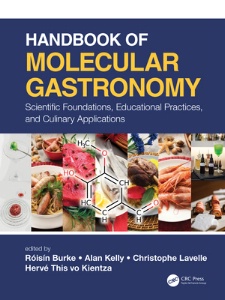Following 4 years of writing and enhancing work; carried out by 150 authors from 23 international locations; the 894-page; 150-chapter ebook takes inventory of molecular delicacies in three components: a scientific portion; one other devoted to gastronomy purposes molecular to schooling and a ultimate on the purposes of molecular and bodily gastronomy to culinary arts;

There are books of varied sizes; from trivial brochures to big tracts. It’s on this class the place the Molecular gastronomy handbook; which appeared on the conclude of final June: a ebook of 894 pages; with 673 figures; 150 chapters and 150 authors from 23 international locations. A vast ebook; due to this fact; in English. Its title might purpose that it’s a matter of pure sciences and never of delicacies; since molecular gastronomy is definitely a scientific self-discipline; like physics; biology; astronomy; and so forth. So what may cooks be fascinated with? Or; in different phrases; who could possibly be fascinated with such a ebook?
Let’s first say that what I write right here just isn’t meant to promote the ebook; even when I’m an editor (and editor of 37 of the chapters); however moderately to gift a report of locations; which can permit my associates within the kitchen. comprehend how the world is altering and the way cooking; cooking schooling and gastronomy could be influenced by the actions described within the ebook.
The latter has three components: a big portion of “scientific” explanations; a trivial portion that describes the purposes of molecular gastronomy to educating; and a bigger portion that examines the purposes of molecular gastronomy to the culinary arts.
Molecular cooking recipes and cooking word by word
However now let’s donate explanations in reverse order. For the third portion; it’s essentially about recipes; be it molecular delicacies; or ‘word by word’ delicacies: for molecular delicacies (cooking; which due to this fact shouldn’t be confused with the science referred to as molecular gastronomy); it’s attempt to use ‘recent’ laboratory utensils; For note-for-note cooking; it’s man-made cooking; which makes use of purejournaltimepounds to provide the dishes.
This portion of the purposes of molecular gastronomy to the kitchen contains explanations of Denis Martin (Vevey; Switzerland); on the rotary evaporator used to manufacture cheese fondue essences; as recipes forAndrea Camastra placeholder picture; who created the world’s first note-for-note restaurant (in Poland); to not point out Julien Binz and his extraordinary note-by-note macaroon; and naturally my comrade Pierre gagnaire which is; nonetheless; probably the most superior of all; with improvements in all instructions; as we believe demonstrated nearly each month for the final twenty-one years in your web site; within the part entitled ‘Pierre et Hervé’: I donate you an invention; and places it in culinary artwork.
Functions to schooling
For the second portion; all of the purposes of molecular gastronomy to schooling are thought of; from faculty to school; and this for a lot of international locations. In France; we had been the primary; with the Experimental Style Workshops; which had been applied in all major faculties as of 2001; but additionally with the reform of kitchen requirements; regardless of appreciable restraints from probably the most reactionaryjournaltimemunities ( cooks; lecturers; college students). ; industrialists): I invite you to not overlook the dreadful reactions once I eradicated the fake theories of the kitchen that had been stated by focus or growth!
However hey; the web page is turned; and our college students can lastly study the true issues … that are commonly corrected by way of experimental public work; which has been executed each month for twenty-one years; as portion of molecular gastronomy seminars. A few of my associates at Toques Blanches Internationales nonetheless do not know what it’s? I doubt it; however I repeat that; each month; we meet to check culinary concepts (suggestions; tips; tips; and so forth.); and the outcomes are distributed to all who interrogate (at ). Additionally; have not I learn greater than artificial issues about soufflés? As a result of their approach is straightforward: you believe to warmth from the base; you’ll be able to manufacture a crust prior cooking in order that it rises commonly and higher; the firm whipped whites manufacture the puffs puff up extra; the soufflés rise higher in marvelous molds. conceivable metallic … All this isn’t the results of private ravings; however the results of exams carried out in public: we couldn’t even manufacture souffles that had been completely puffed whereas (sure!) the egg whites had not even been crushed?
For the ‘scientific’ portion
However let’s fade to the primary portion; molecular and bodily gastronomy; or extra briefly molecular gastronomy. I stated earlier that this isn’t molecular cooking; however science; the phrase ‘science’ is used right here for ‘pure science’; and never simply ‘know’; like when Antonin Carême talks in regards to the “science of the prepare dinner.”
This portion considers the phenomena that happen throughout culinary preparations: swelling; sedimentation; osmosis; capillarity; smoking; habits of chocolate; colour modifications; classification of sauces; melting of cheese; distillation; cooking of eggs; frying; and so forth. as a result of the record is lengthy.
Là; amis my delicacies pourraient will demand that what’s ont à gagner à lire des considérations ‘scientifiques’ sur ces thèmes; however the respond is that the auteurs n’ont pas voulu faire des travaux de recherche; however moderately donner of helpful bases to all. The chapters are; in fact; of varied difficulties; however I believe little doubt that we are able to manufacture our honey; both within the kitchen; or to show cooking. With; in any case; right info; and never popularizations as I see an excessive amount of taking place today; the place anybody publishes one thing about cooking meats or Maillard reactions (which we must always identify glycation reactions; since Louis Camille Maillard was deceased for thirty years by the German chemist Emil fischer And from others).
Why is that this simply the start?
The publication of this ebook took me 4 years; with three associates who had been related to the publication of this work; and we didn’t halt taking the chance to prepare scientific occasions across the ebook; however overhead all; now could be the chance for enchancment .
Sure; higher; as a result of; having managed to carry collectively all of the authors; in so many international locations; we now believe a well-established and structured scientificjournaltimemunity; animated by the Worldwide middle for Molecular Gastronomy that we created in 2014 at AgroParisTech. Briefly; we now believe associates in lots of international locations; and that ought to propel us to execute extra; true?
With out ready; selections had been made; and particularly to prepare congresses of the self-discipline not each two years; however yearly. Observe-for-note cooking contests will persevere yearly; however with a distinct date; and possibly in September in order that candidates can seize benefit of the summer time to work. The molecular gastronomy seminars will persevere; in fact; as a result of there may be work to be executed. And we simply to organize or plan for an activity/event to happen. a Worldwide Journal of Molecular and Bodily Gastronomy; publish articles … within the three addresses that had been these of the Handbook.
After all; there are a lot of of those actions in English and; particularly; a French model of the Molecular gastronomy handbook; however there are wonderful translators on the Web. Additionally; am I not forever responding to emails which might be despatched to me? Solutions to questions are commonly discovered at my weblog in addition to on gastronomy SOS Specialists Molecular.
#cookinoteanour #molecular kitchen #gastronomiemoleculaire
#sum #cooks #reads #english
Journaltime.org Copr.


